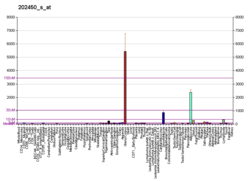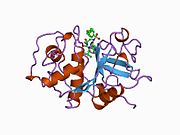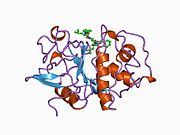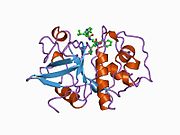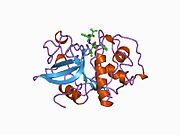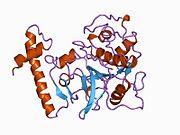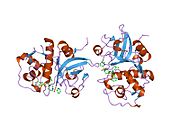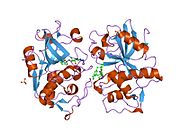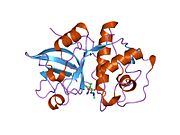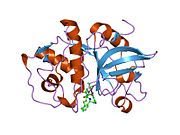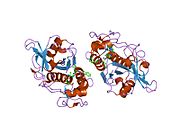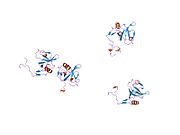Cathepsin K
Cathepsin K, abbreviated CTSK, is an enzyme that in humans is encoded by the CTSK gene.[5][6]
Function
The protein encoded by this gene is a lysosomal cysteine protease involved in bone remodeling and resorption. This protein, which is a member of the peptidase C1 protein family, is expressed predominantly in osteoclasts.
Cathepsin K is a protease, which is defined by its high specificity for kinins, that is involved in bone resorption. The enzyme's ability to catabolize elastin, collagen, and gelatin allow it to break down bone and cartilage. This catabolic activity is also partially responsible for the loss of lung elasticity and recoil in emphysema. Cathepsin K inhibitors show great potential in the treatment of osteoporosis. Cathepsin K is degraded by Cathepsin S, called Controlled Cathepsin Cannibalism.
Cathepsin K expression is stimulated by inflammatory cytokines that are released after tissue injury.
Clinical significance
Cathepsin K is expressed in a significant fraction of human breast cancers, where it could contribute to tumor invasiveness.[7] Mutations in this gene are the cause of pycnodysostosis, an autosomal recessive disease characterized by osteosclerosis and short stature.[8] Cathepsin K has also been found to be over-expressed in glioblastoma.[9]
That the expression of cathepsin K is characteristic for some cancers and not others has been documented.[10] Cathepsin K antibodies are marketed for research into expression of this enyzme by various cells.[11][12]
Merck had a cathepsin K inhibitor, odanacatib, in Phase III clinical trials for osteoporosis. In September, 2016, Merck announced they were discontinuing development of odanacatib after their own assessment of adverse events and an independent assessment showed increased risk of stroke.[13][14] Other cathepsin K inhbitors are in various stages of development.[15][16][17]
References
- ^ a b c GRCh38: Ensembl release 89: ENSG00000143387 – Ensembl, May 2017
- ^ a b c GRCm38: Ensembl release 89: ENSMUSG00000028111 – Ensembl, May 2017
- ^ "Human PubMed Reference:". National Center for Biotechnology Information, U.S. National Library of Medicine.
- ^ "Mouse PubMed Reference:". National Center for Biotechnology Information, U.S. National Library of Medicine.
- ^ "Entrez Gene: CTSK cathepsin K".
- ^ Inaoka T, Bilbe G, Ishibashi O, Tezuka K, Kumegawa M, Kokubo T (January 1995). "Molecular cloning of human cDNA for cathepsin K: novel cysteine proteinase predominantly expressed in bone". Biochem. Biophys. Res. Commun. 206 (1): 89–96. doi:10.1006/bbrc.1995.1013. PMID 7818555.
- ^ Duong, Le T. , Wesolowski, Gregg A., Leung, Patrick Oballa, Renata and Pickarski, Maureen (23 September 2014). ""Efficacy of a Cathepsin K Inhibitor in a Preclinical Model for Prevention and Treatment of Breast Cancer Bone Metastasis"". Molecular Cancer Therapeutics; 13(12);. American Association for Cancer Research. pp. 2898–909. Retrieved 2 October 2016.
{{cite web}}: CS1 maint: extra punctuation (link) CS1 maint: multiple names: authors list (link) - ^ ""CTSK cathepsin K [ Homo sapiens (human) ]"". NCBI Gene. National Center for Biotechnology Information, U.S. National Library of Medicine. 4 September 2016. Retrieved 2 October 2016.
- ^ Verbovšek, Urška, Motaln, Helena, Rotter, Ana, Atai, Nadia A., Gruden, Kristina, Van Noorden, Cornelis J.F., Lah, Tamara T. (30 October 2014). ""Expression Analysis of All Protease Genes Reveals Cathepsin K to Be Overexpressed in Glioblastoma"". PLOS ONE. LOCKSS. Retrieved 2 October 2016.
{{cite web}}: CS1 maint: multiple names: authors list (link) - ^ Argani, Pedram; et al. (1 February 2013). ""A Broad Survey of Cathepsin K Immunoreactivity in Human Neoplasms"". American Journal of Clinical Pathology, Volume 139, Issue 2. Oxford Journals. pp. 151–159. Retrieved 2 October 2016.
{{cite web}}: Explicit use of et al. in:|author=(help) - ^ ""Cathepsin K Antibodies"". Novus Biologicals online catalog. Novus Biologicals, LLC. 2016. Retrieved 2 October 2016.
- ^ ""Anti-Cathepsin K antibody (ab19027)"". Abcam plc online catalog. Abcam plc. 2016. Retrieved 2 October 2016.
- ^ Brömme, Dieter, Lecaille, Fabien (24 April 2009). ""Cathepsin K inhibitors for osteoporosis and potential off-target effects"". Expert Opinion on Investigational Drugs, Volume 18 2009 - Issue 5. Taylor & Francis Online. pp. 585–600. Retrieved 2 October 2016.
{{cite web}}: CS1 maint: multiple names: authors list (link) - ^ ""Merck Provides Update on Odanacatib Development Program"". Merck Sharp & Dohme Corp. 2 September 2016. Retrieved 1 October 2016.
- ^ Asagiri M, Hirai T, Kunigami T, Kamano S, Gober HJ, Okamoto K, Nishikawa K, Latz E, Golenbock DT, Aoki K, Ohya K, Imai Y, Morishita Y, Miyazono K, Kato S, Saftig P, Takayanagi H,. (2008). Cathepsin K-dependent toll-like receptor 9 signaling revealed in experimental arthritis. Science, 319(5863), 624-627.
- ^ Hussein, H., Ishihara, A., Menendez, M., & Bertone, A. (2014). Pharmacokinetics and bone resorption evaluation of a novel Cathepsin K inhibitor (VEL‐0230) in healthy adult horses. Journal of veterinary pharmacology and therapeutics.
- ^ Ren, Zhong-Yuan; Machuca-Gayet, Irma; Domenget, Chantal; Buchet, Rene; Wu, Yuqing; Jurdic, Pierre; Mebarek, Saida (13 July 2015). "Azanitrile Cathepsin K Inhibitors: Effects on Cell Toxicity, Osteoblast-Induced Mineralization and Osteoclast-Mediated Bone Resorption". PLoS ONE. 10 (7). doi:10.1371/journal.pone.0132513. ISSN 1932-6203. PMC 4500499. PMID 26168340.
{{cite journal}}: CS1 maint: unflagged free DOI (link)
Further reading
Additional images
External links
- The MEROPS online database for peptidases and their inhibitors: C01.036
- Cathepsin+K at the U.S. National Library of Medicine Medical Subject Headings (MeSH)






